#he was already seen as a walking calamity/natural disaster as a human
Text

"Know your place, fool." ⛩
I really want to know more about how he became the King of Curses
#Sukuna#Ryomen Sukuna#Ryoumen Sukuna#Jujutsu Kaisen#JJK#Jujutsu Kaisen fanart#JJK fanart#luxites art#loosely based on the unwanted child / ''I bet I was a creepy kid'' line#he already has 4 arms here btw I just think he hid them in his kimono early on#he was already seen as a walking calamity/natural disaster as a human#so I'm just really interested in how others perceived him as he grew up#and when he started refining his skills and learning how far he could go#THOUGHT THAT THE BG WOULD BE SIMPLE BUT IT TOOK FOREVER#I don't usually work with these colors it was fun#I can show process pics of this if anyone want to sends an ask#I just didn't want to put them under a read more#EDIT: UPDATED CUZ TUMBLR?? CROPPED IT A BIT???#it was only noticeable to me tho
484 notes
·
View notes
Text
Self-awareness in the disaster situation of Barangay San Isidro, Valley 2, Parañaque City

On December 26, 2019, I had a visit on our Barangay City Hall, which is located on San Isidro, Sucat, Parañaque City (Hence, Barangay San Isidro). The Barangay Hall will be confusing to many, especially to newcomers like me, since there are many doors which lead to different organizations and departments of the Barangay.
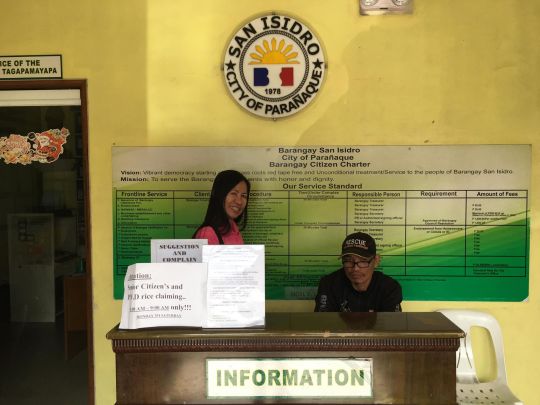
On my visit there with my mom, I was greeted by two people from the information desk and was asked what my initiative was of being there, to which I asked of who I can interview inside the Barangay pertaining to BDRRM. They then pointed the door to the left which led to another room, in which I met Mr. Raul Grafil, a Barangay Executive Officer.
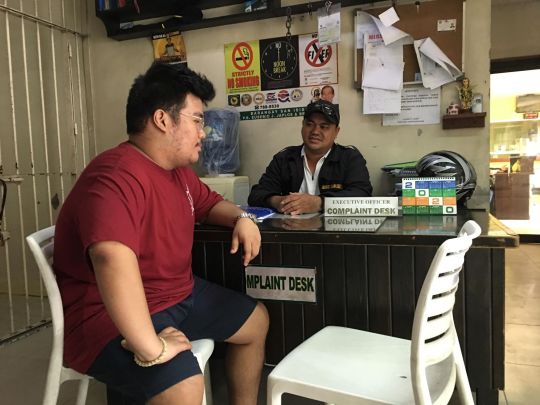
I asked him if I can interview him for my NSTP, specifically about BDRRM I said, to which he obliged. I showed him first the list of questions and soon after, we got the interview going. When asked about the hazard identification questions, he remembered when Bagyong Ondoy striked us (on 2009), then there was the rally and violent confrontation between the police and the people of Silverio (the place beside the Barangay Hall), and Parañaque being under the state of calamity because of the rising number of dengue cases. For typhoons, it randomly appears and God-made, so it is usually frequent, but not as great as of Ondoy. Then for the rally and the rising dengue cases, it seldomly happens, since those were man made, and the dengue cases were the result of our own negligence, specifically, by not throwing our trashes in proper places, accumulated unclean water in some places, etc.
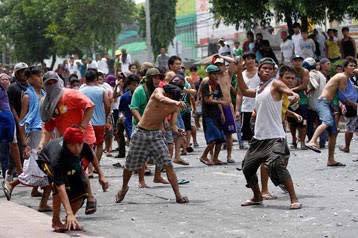
Silverio Demolition
Credits to: ABS-CBN News
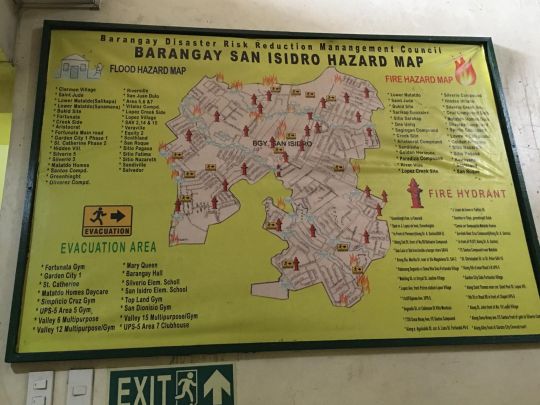
For the vulnerability and risk assessment, he (Mr. Grafil) brought me to the hazard map of Barangay San Isidro. The map showed everything I needed to know about where to go and not to go in times of need. The map indicated where flood and fire hazards are most probable and evacuation areas, places that are the safest to go to if a typhoon or calamity happens. He told me that those near the flood and fire hazard symbols in the map are the most affected if a typhoon is to happen since they are the ones that need to evacuate early and leave their homes since it not safe anymore, and that they are the most prone to the effects of the calamity to happen. He also added that everytime a calamity happens, it’s very hard since people don’t usually listen to what they’re saying, thinking that it’s not going to have a disastrous effect and “lilipas rin”. He said, “Okay naman paminsan minsan, kasi minsan hindi naman talaga kailangan mag evacuate, para lang sigurado, pero may mga beses talaga na kahit pinipiliit na nating mag evacuate, wala talaga, ayaw.” This was one of the hardest problems they encounter which also gives a harder after effect, since those who did not evacuate are those most needing of help.
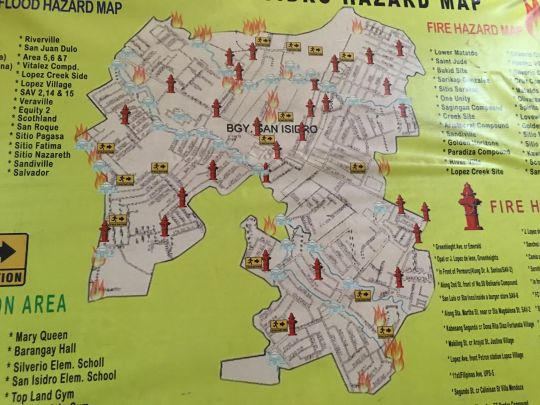

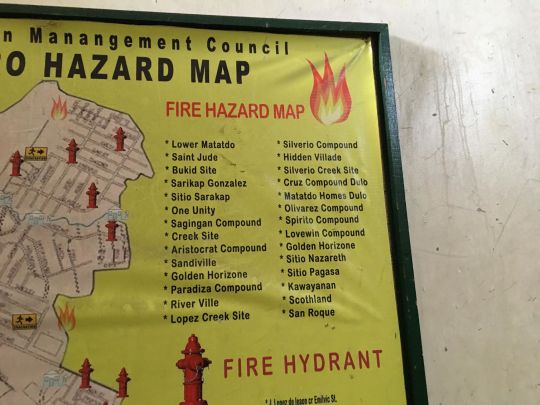

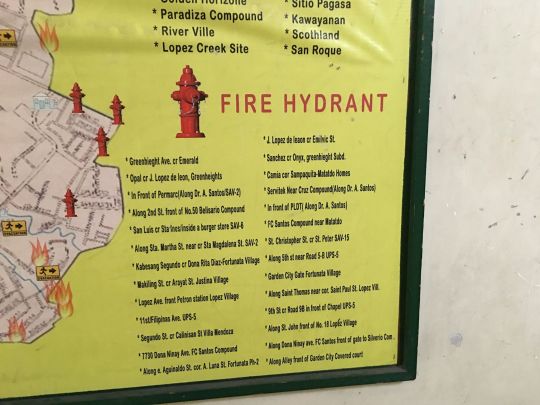
After that, I took some pictures of their emergency equipment stored besides the stairs. They have the necessary equipment needed in cases of emergencies, such as life vests, ropes, hoses, machineries and such.
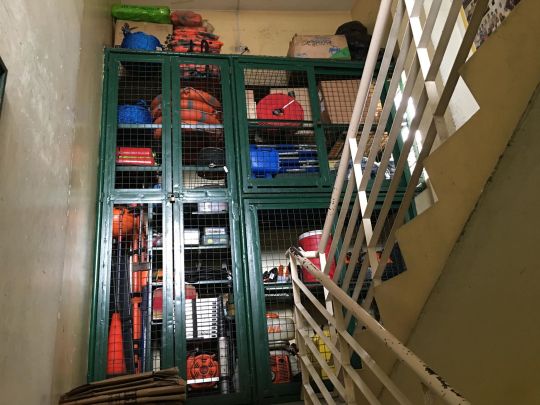
Soon after, he showed me proof that Parañaque is always prepared and preparing for the better by showing the awards the Barangay won (Disaster Resilient Barangay, Best in Solid Waste Management and Cleanest Waterways).

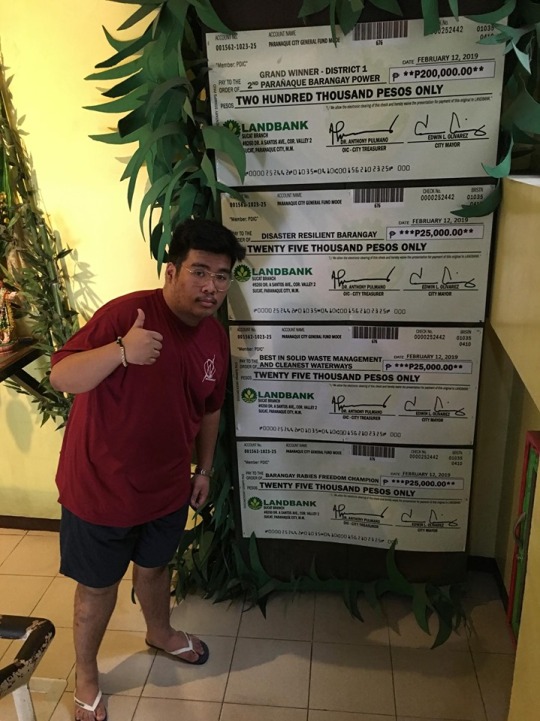
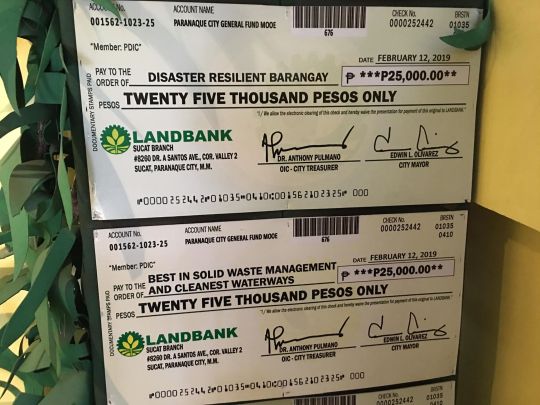
We then got back to the room where we first met, and in there I asked the questions pertaining to the Disaster Management Assessment. He told me that if constant rain is imminent or a typhoon is coming, they usually post announcements, warnings, reminders and important information in their Facebook page (Paranaque City Disaster Risk Reduction and Management Office). He said that the Barangay conducts assessments before, during, and after a typhoon to have the proper preparations made for the people and for future typhoons to come. They also conduct trainings and orientations for people who may help the community in the future in times of hazards and disasters, and immersions for students which include community preparation. It is the City Disaster Risk Reduction and Management Council/Office, with the help of Consumer Welfare Office, and Bureau of Fire Protection, that help the community in facing a calamity or disaster. After that, I thanked him and took a picture with him, before leaving and learning new things on how to help in having a better tomorrow.
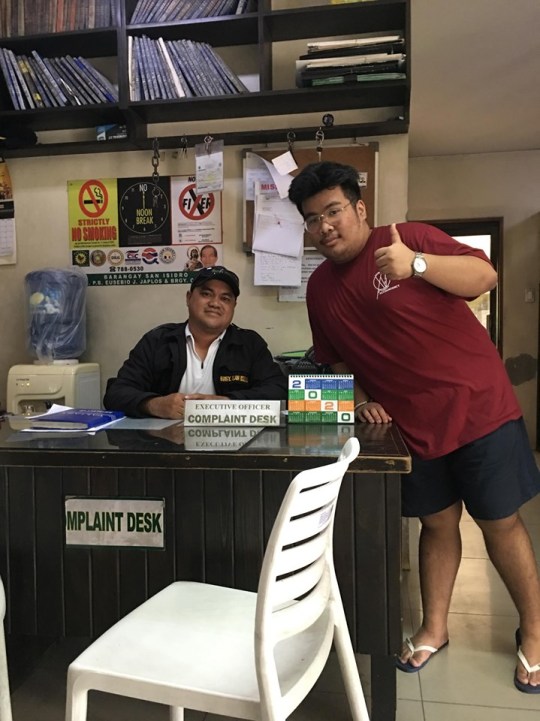
As we took pictures outside for the community walk, I can’t help but notice clogged sewages in front of the Barangay Hall, and as we crossed the street, there was a big dumpster of garbage on the road. This is a very hazardous practice since if those garbages drain our sewages in times of typhoons and heavy rain, the flooding is very much imminent.
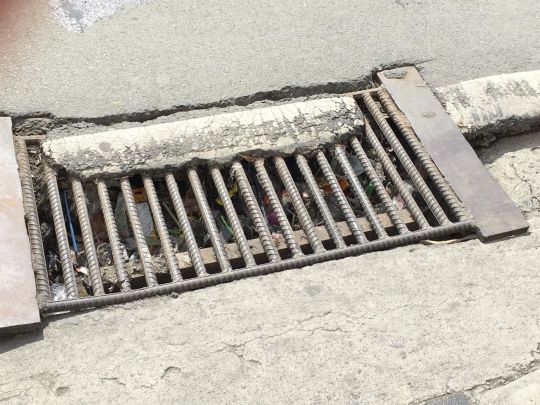

As for safe spaces, the St. Catherine Court (can be seen in the “evacuation area” part of the hazard map) is located in Valley 2, Sucat inside the St. Catherine Subdivision and is open to everyone who needs to evacuate out of their homes. It is very much safe since it is in the higher ground of the subdivision and not prone to flooding.
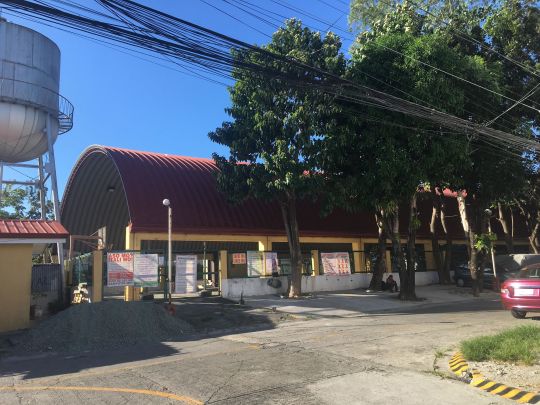
They also practice waste segregation and collection of water bottles, which is the best practice since it prevents clogging of sewages. They are also constructing new sewage systems, an extension of those already constructed near our homes, to further decrease flooding in times of rain. For me, it’s harmful in the short run but beneficial in the long run, since the construction of those sewage systems are left behind and when it rains, it makes it hard for pedestrians to walk in the proper sidewalk and are forced to walk on the road which is dangerous, but when all of it is complete, we will all benefit and be less prone to the effects of flooding.

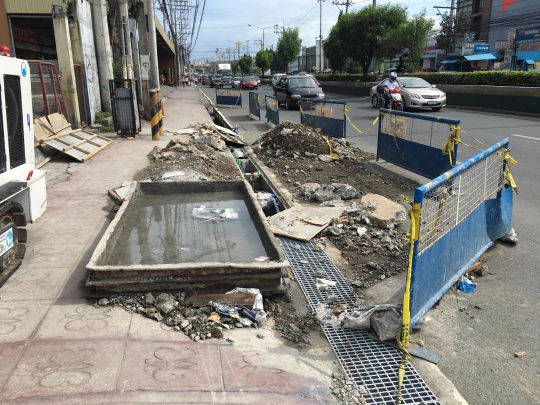
Based on the kwentuhan and community walk, I can describe the community as well prepared, since they have the necessary equipment needed ready in cases of calamities and disasters. They have fire trucks, life rafts, the equipment, and they also have a hazard map. One thing that was not provided to me was a BDRRM plan, which could have been very helpful, since they did not have any more copies. They know in what areas of the Barangay are more prone to fire and flood, which is very much needed in times of calamity so that they know what their area of focus will be. This also shows that the barangay knows the strengths and weaknesses of different places in the community, which is very helpful in times of emergencies. Then, the government agencies and departments of our city and Barangay are helping together to reaching out to our fellow people of San Isidro in how we can all prepare and minimize risks and the disasters that are to come. The community is clean due to the practice of solid waste management, but can be better since garbage are still everywhere (not solely based on them but also because of the lack of discipline of the people). If the Barangay can easily provide anyone with their BDRRM plan, clean the sewages, and create more seminars and programs for its people, then I can say that they really are deserving of the awards they were given. The issues confronting the community are flooding, the rising number of cases of dengue, and garbage everywhere. I think these issues are happening in the community primarily because of clogged sewages and drainages, which is because of garbage everywhere, which is because of the lack of discipline of the members of the community that don’t practice “clean as you go” and simply throw their trash anywhere, and because of this, water is left in different places, which then becomes the source of mosquitos which then causes dengue. For me, all of the problems are interconnected because all of the reasons for it happening are also interconnected. The possible solutions the local government to address these issues are first, implement a better policy in waste management, like banning plastics, making those who are not following the law clean sewers and garbages, and be more vocal in waste management practices by creating seminars, workshops, immersions for students, and posting in social media for better awareness of the people. Relating this to the disaster situation of our country, we ourselves are the ones who are making us unprepared for disaster and even we do become prepared, politics and corruption take place. We cut off trees and replace it with buildings, we throw our trash in improper places, we don’t listen to the authorities when a calamity is to strike, and when a calamity or disaster happens, it is us who cries the loudest for help. Yes, it is in the nature of the Filipinos to help each other in times of need. President Manuel L. Quezon once said, “the Philippines is our country, and the only country God has given us. We must live for it and die for it, if necessary.” Yet, we live for our country and let it die on its own. If only the country realizes that money won’t give us second lives. The country needs to have discipline, politics that actually care for the country and not for the congress’ sake only, and actually helping each other in giving life and preserving life with one another. Only by then can we actually be prepared and rise up from disasters and calamities. My realizations from the kwentuhan and community walk that even the smallest of things can make the biggest difference. By practicing “clean as you go” in everywhere I go, I contribute in helping the community have a proper waste management system, which then lessens clogged sewages, which then results to less or no accumulated water, which then results to no presence of dengue. The community is affected by everything we do, and if only every member of the community can see it, then we will all benefit from it. We need to address the issue of disaster in our country because it disregards the value of human life. Disasters kill innocent people and affects usually the poor and the needy, for they don’t have the necessary items they need to protect themselves from the disasters to come. We need to address it because it is a problem that we cannot control, but we can reduce its harmful effects to the people and lessen the number of casualties. By addressing disasters, we preserve the value of human life, as all humans should do. We can address it first and foremost, by planning. We can address it by knowing what the problems are, what are our weaknesses, our strengths, what can and cannot be fixed, all the variables present, and how can we solve it. Second, by helping each other. One cannot do it alone, but together, together we are strong. And lastly, by throwing our pride aside and caring for our country and its’ future. As a member of the community and this nation, the possible solutions I can do to address the vulnerabilities by being vocal of how I can help and how others can also help. Since we are in the age of technology, I can make publishing materials in social media which aims to show awareness in our community in terms of disaster, waste management, and how we can all help create a better community. Also, people today are visual learners, so them seeing videos and images, even memes, whose goal is to show awareness will create much more awareness to everyone. Actions that I should take to increase the capacities of my community and country, as a student, is listening and being active in my NSTP class and volunteering in Red Cross. For me, I cannot help others if I am still powerless. Therefore, if I listen to my NSTP professor, read the modules, opening my eyes in the bigger picture, then I become prepared in teaching to others what was taught to me. By volunteering again in Red Cross (I volunteered in High School), I then have the necessary skills to help others and at the same time, hone my skills so that when the time comes, I can help others so that may also help those who are in need. In this way, we create a system in the community that cares for itself and creates a better future for our children, our childrens’ children, until the world is no more.
1 note
·
View note
Text
Disaster Preparedness and Management in the Local Community

Disasters are one of the most natural and recurring events that can strike a particular area at any given time. These can range from calamities such as typhoons and floods, to devastating hazards such as earthquakes, tsunamis, and volcanic eruptions. The Philippines is one of the most disaster-prone countries in the world, and its natural state causes us Filipinos to prepare, implement, and develop disaster management plans to increase our resilience and lessen our vulnerability to approaching disasters.
With this, local communities such as barangays have also implemented their own disaster risk preparedness in order to educate and orient its community members on what to do during such events.
My barangay is situated at Barangay 502, located in the City of Manila under the administrative district of Sampaloc. It’s total voting population is approximately 400 citizens, and it is currently ran by the administration of Mr. Jose M. Dee.
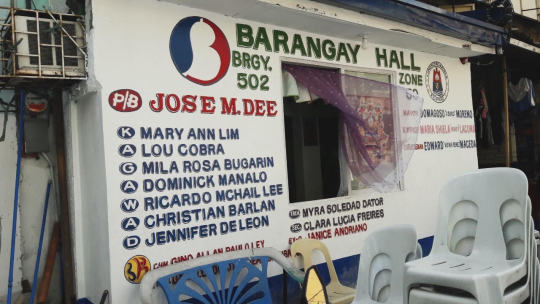
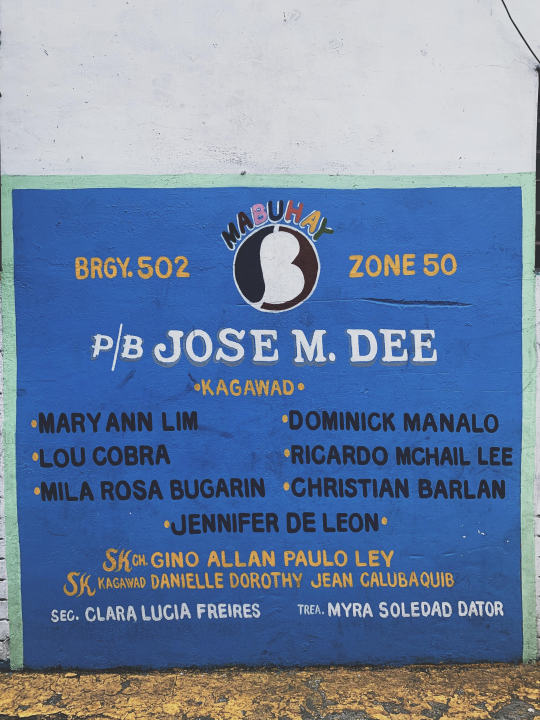
Before becoming the current Barangay Chairman, he first began as a Barangay Kagawad for served for 19 years before deciding to run for Chairman. In his history of work, he had seen and experience the different adversities of the Barangay. According to Mr. Dee, the major hazards and risks that frequently struck the barangay are typhoons and drastic floods. He emphasized that among the calamities he had experienced, Typhoon Ondoy was by far the worst and most devastating. It was during this time that the streets and drainage systems in the district of Sampaloc have not been renovated, and so most houses that lined the shallow streets were consumed by floods. Moreover, the series of typhoons that followed after Ondoy also made it difficult for the barangay officials to clean the surrounding area and drain the leftover flood.
In my initial interview with Mr. Dee, I learned that the issues confronting the community were mostly typhoons and floods. I believe that these disasters happening in the community is the result of our human activities, such as throwing trash recklessly in the streets and not having proper waste disposal. Mr. Dee said that one of the founding problems in the barangay that caused drastic floods were poor drainage system, and this convinced me that us residents also have a negative contribution to the hazards that happen in the community. Our ignorance and lack of discipline make the effects of hazards worse, thereby increasing the damage to our community.
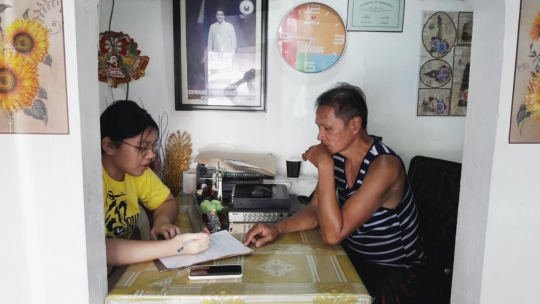
Mr. Dee claimed that typhoons and storms struck the barangay annually during the rainy seasons of June to October. He and the other officials already anticipate the incoming rains during this time, and they made sure to listen to the radio and news announcements to effectively prepare for calamities.
In the event that calamities do strike the community, Mr. Dee stated that areas with the most evident damage will be those houses in the shallower streets. The most affected will be those residents who only have single-story homes with no second floors, or those who do not have homes at all. Calamities can damage the infrastructures, buildings, and houses of residents and can cause diseases and illnesses in humans such as fever, dengue, and leptospirosis.
The disaster situation in my community can be greatly related to the conflicts faced by the Philippines during calamities. When typhoons and storm surges hit a particular area in the country, it suffers the same amount of damage as anywhere else. It causes flooding, it ruins communities, and it creates communicable diseases that cause death to humans annually. This is where the importance of disaster risk preparedness and management comes in. It should be duly recognized and implemented by all communities in the country so that we could have a better response and preparation for such disasters, as well as to rehabilitate and recover faster afterwards.
The barangay’s disaster preparedness and management involves improving the waste management and disposal of the areas and frequent checking of the infrastructure’s conditions. During calamities, he and the barangay officials also monitor the flood levels and check the safety of its residents. Sometimes, they also give out free lugaw or champorado. In the future, Mr. Dee plans to place fire extinguishers around the barangay, and to conduct more fire and earthquake drills for its residents. He is also planning to construct a bigger and wider court to create a hazard-free space in times of earthquakes.

After the interview, my dad and I took a short walk around the neighborhood to take note of the community’s safe and hazardous places.


The first thing I noticed right away was the location of the barangay hall of my community. Mr. Dee owns a kariton business next to the barangay hall, which was exactly beside a gas station. I identified this as a hazardous place. When a fire is situated in or near the barangay hall, it could grow faster and become bigger due to the presence of flammable materials. When it comes in contact with the gas station, it could cause a massive explosion.
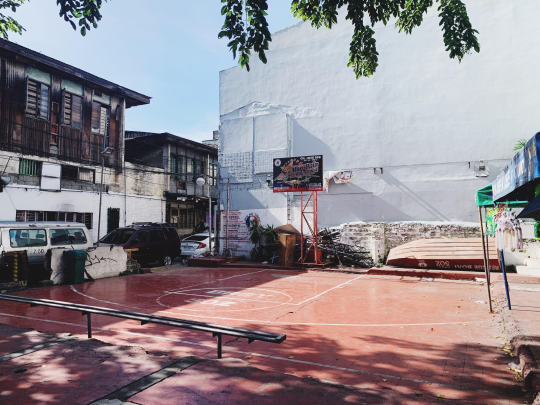
A safe place in the community is the open court facing Espanya boulevard. It is not as big to cater all of its residents in one space, but earthquake drills and stimulations can be practiced here for good measure and preparedness.


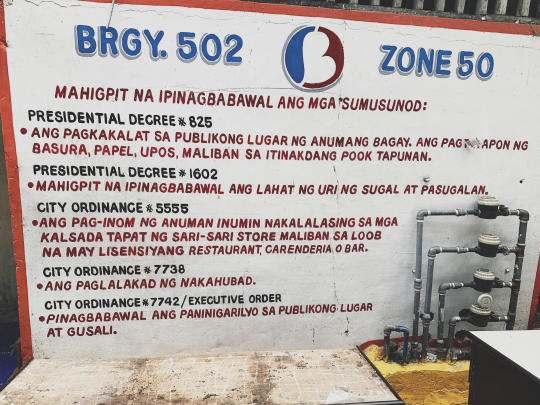

Furthermore, I also identified the best practices implemented by the Barangay. The boat in the first picture can be seen at the open court, where it is used by the officials in times of high and damaging flood. Some outposts in the community also have its designated water level measurement to determine if the flood is still passable or not.
These wall inscriptions found near the barangay hall also serve as best practices in reminding its residents in times of disaster. The second photo shows a list of emergency hotlines that people can contact for immediate help. Meanwhile, the third photo displays the different laws and regulations for people in the barangay to follow. It also emphasized on the regulations for garbage disposal so as to prevent future drastic flooding.
OVERALL REFLECTION AND SYNTHESIS
After conducting my BDRRM kwentuhan and community walk, I came to the realization how important disaster risk preparedness and management is in readying all of us for crisis, disasters, and calamities. Recognizing the impacts of disasters is equally important as determining the things we can do to prepare for it and recover from it right away. Moreover, the community walk taught me that it is essential to be familiar to your community and its potential hazards. One of my barangays main problems were flooding due to inefficient waste disposal, and being aware of my community helps me to discipline myself better in throwing trash. Being knowledgeable of your surroundings can contribute greatly to your safety and chances of survival.
We need to address the issues of disaster in our country because it could also mean our suffering and inability to survive. Being aware of the impacts of disasters enables us to plan, produce, and implement strategies to combat its damaging effects. It is also a way for us to identify our resources and skills to increase our resiliency and cope better in times of disaster. We can address these adversities by improving on community planning that will establish the needs of the community members and its susceptibility to hazards, making community disaster evacuation maps more accessible and available to all citizens, and conducting frequent assessments of vulnerable communities.
Similarly in my own way, I could use this knowledge gained in my NSTP to raise awareness and educate people on what we should do in times of disasters.
Other sources used:
1. NSTP-CWTS Chapter 4: Disaster Risk Reduction and Management https://ust.blackboard.com/bbcswebdav/pid-2324934-dt-content-rid-22103812_1/xid-22103812_1
2. NDRRMC: National Disaster Risk Reduction and Management Plan 2011-2028 http://www.ndrrmc.gov.ph/attachments/article/41/NDRRM_Plan_2011-2028.pdf
Pauline B. Panganiban
C-AB-8
1 note
·
View note
Text
THE SIGNS (PART 3)
Can I pray for you in any way?
Send any prayer requests to [email protected]
In Christ, Mark
~~~~~~~~~~~~~~~~~~~~~~~~~~
** Follow The Christian Walk on Twitter @ThChristianWalk
** Like posts and send friend requests to the author of The Christian Walk, Mark Cummings on Facebook at https://www.facebook.com/mark.cummings.733?ref=tn_tnmn
** Become a Follower of The Christian Walk at http://the-christian-walk.blogspot.com
~~~~~~~~~~~~~~~~~~~~~~~~~~
The scriptures. May God bless the reading of His holy word.
There will be famines and earthquakes in various places. All these are the beginning of birth pains.
Matthew 24:6-7b
There will be earthquakes in various places, and famines. These are the beginning of birth pains.
Mark 13:8b
There will be great earthquakes, famines and pestilences in various places, and fearful events and great signs from heaven.
Luke 21:11
This ends today’s reading from God's holy word. Thanks be to God.
Today, we continue our series on signs, signs Jesus spoke about to four of His disciples - Peter, Andrew, James, and John - who were none other than the first four people He called to follow Him. We know Jesus was telling of these signs while sitting on the Mount of Olives, overlooking Jerusalem’s temple. This is why this particular conversation is often referred to as the last of the Olivet Discourses.
Well, today is part three of this series as we break down the indicators that would precede Jesus’ return. Thus far, we have been told to watch out for Jesus imposters and wars as nations and kingdoms fight against one other. Each of these first two signs is initiated by mankind but as we see today, nature will provide its own set of signals. Look again at these scriptures:
There will be famines and earthquakes in various places. All these are the beginning of birth pains. Matthew 24:6-7b
There will be earthquakes in various places, and famines. These are the beginning of birth pains. Mark 13:8b
There will be great earthquakes, famines and pestilences in various places, and fearful events and great signs from heaven. Luke 21:11
Everyone likes standing on solid ground so much so that we often take it for granted. This is why earthquakes are particularly scary events because the instability that causes the ground to tremor, quake, and even split comes from below. It’s what makes an earthquake unique from other natural disasters.
But note that it won’t only be earthquakes the earth will be dealing with. There will be other threats, threats that will originate more from above.
The first mentioned her is famine. Most often, this calamity which causes the loss of life sustaining food, results from lack of rainfall and nearly everything alive needs water to survive. This goes for plants, animals, and of course, human beings.
Famines happened often in biblical days, often times as an instrument of judgment from God unto His people. You can find mention of famines in the Old Testament books of Genesis, 2 Samuel, 1 and 2 Kings, 1 Chronicles, Job, Ruth, Nehemiah, the Psalms, Lamentations, Isaiah, Jeremiah, Ezekiel, and Amos as well as in the New Testament within the Gospels, the Book of Acts, and the Book of Revelation. In these times, many people would die along with the plants that went unwatered and the animals that went unfed and dehydrated. No food and no water was not a good combination then and it wouldn’t be today or any other time for that matter.
Of course, lack of rainfall wasn’t the only cause of famine. Go to chapter 10 of Exodus and you’ll find God sending locusts to plague the nation of Egypt as Pharaoh refused to release the Israelites from captivity. The swarm of insects invaded Egypt and the scriptures share how devastating the event was:
Never before had there been such a plague of locusts, nor will there ever be again. 15 They covered all the ground until it was black. They devoured all that was left after the hail—everything growing in the fields and the fruit on the trees. Nothing green remained on tree or plant in all the land of Egypt. Exodus 10:14b-15
It was complete devastation of all crops in Egypt and not a tree or plant was left undevoured. And to put a more modern day twist on this, recently a great swarm of locusts formed on the African continent and started to cause great destruction. There was such a concern about widespread famine that experts scrambled to come up with an urgent eradication plan to wipe out the insects before they had a chance to reproduce and get beyond control.
Whether caused by lack of rainfall or insects, famine is a serious event and before Jesus returns, we will see them happen in our world.
Going back to the scriptures, we find several other items of mention listed along with earthquakes and famine in Luke’s account. One of these additional signs is pestilence.
There will be great earthquakes, famines and pestilences in various places, and fearful events and great signs from heaven. Luke 21:11
What exactly is pestilence you may ask?
Going to the dictionary, we find this:
“A deadly or virulent epidemic disease.”
Hmmm. Sounds familiar, right?
We can definitely relate to this in 2021 after the COVID breakout but picture this happening on an even larger scale with a disease that is more contagious and deadly. Think about an epidemic raging around the world with no easy remedy, one that has not been seen before. That would be pestilence in its purest form.
It wouldn’t be pretty but in tandem with other signs, it would signal that Jesus’ return was imminent.
Earthquakes, famines, and outbreaks of pestilence.
Any of these would be terrible on their own but now put them in combination with other “fearful events” and “great signs from heaven” and you have the recipe for out and out chaos on a global scale.
It would be enough for anyone to cry out for change and when Jesus returns, change is what He will bring as He makes all things new.
Are you ready for that change when it happens?
You only will be if you accept Jesus as your personal Savior and my prayer today is that you will do just that if you haven’t done so already.
Tomorrow, we’ll see that Jesus is far from done sharing signs that will signal His return. Hope you’ll come back to learn more.
Amen.
In Christ,
Mark
PS: Feel free to leave a comment and please share this with anyone you feel might be blessed by it.
Send any prayer requests to [email protected]
0 notes
Text
Does “Once Saved Always Saved” Mean We Can Enter the Heavenly Kingdom?
By Lingting, United States

The Bible says, “For with the heart man believes to righteousness; and with the mouth confession is made to salvation” (Romans 10:10). Many Christians, therefore, think that they have been saved by faith in the Lord and once saved always saved, so when the Lord comes He will certainly take them into the heavenly kingdom. But it is undeniable that many believers are often incapable of practicing the Lord’s word, living in a state of sinning and confessing. In the Bible it says, “Holiness, without which no man shall see the Lord” (Hebrews 12:14). In that case, would a habitual sinner really be saved and enter the kingdom of heaven? The experience of the author will tell you the answer.
I have believed in the Lord for more than a decade. During this period, I always read the Bible carefully, spread the gospel, did my devotions, drove a car to pick up brothers and sisters and take them back, and supported brothers and sisters. I, however, did not see any true changes in myself. For example, once my husband and child did not listen to me, I could not help getting angry at them; when someone said something bad about me, I would hate him or her in my heart. The Lord Jesus asked us to love others as we love ourselves, but why was it that I simply could not do it? What’s worse, I would even complain about God when encountering adversities. Each time that I sinned, I felt especially regretful, but later I resumed sinning again. I was deeply troubled by this. Sins were like ropes that kept me tightly bound, making me unable to break free from them. I found it very difficult to sin no more. I often asked myself: “Can people like me who are living in sin be saved and enter the kingdom of heaven?”
Later, when I sought with the pastor about my confusion, he replied, “Don’t worry. The Bible records, ‘For with the heart man believes to righteousness; and with the mouth confession is made to salvation’ (Romans 10:10). Because we believe in the Lord Jesus we are already saved and once saved always saved, so when the Lord returns we will be taken by Him to heaven.” After hearing what he said, I still harbored doubts: “Some believers commit major sins, such as committing adultery, conning others out of their money and forming factions, whereas some commit minor sins, such as quarreling with others and cursing others. If believers can enter the kingdom of heaven regardless of the crimes they’ve committed, then it is unfair.” So I expressed my confusion to the pastor again, but he said, “The wages are the same for those who come early and those who come late to the vineyard. The Lord shows kindness to whomever He wishes, even the dying patients. As long as they are baptized, then irrespective of how great evil they have performed, they will enter heaven after death.” His answer didn’t resolve my confusion, which still remained in my thoughts.
Through a chance encounter, I met Sister Liu from mainland China at a birthday party of one of my friends. We hit it off. She is a preacher and has a lot of experience of having faith in the Lord and a very pure understanding of the Bible. Her fellowship was very illuminating, which really drew me in. As a result, I told her about my confusion: “The Bible says only those who are holy can see God’s face. However, even though I’ve believed in the Lord for many years, I’m still in the cycle of sinning and repentance, unable to free myself from the bonds of sin. Therefore, I really suspect that I cannot enter the kingdom of heaven. Yet my pastor told me, ‘To be saved once is to be saved forever. As long as we accept the Lord Jesus’ redemption, regardless of what sins we commit, when the Lord returns we will be raptured into heaven.’ Sister Liu, do you think he is right?”
Hearing my question, Sister Liu smiled and said, “Sister, your question is quite good and just what many believers are confused about. In regard to this aspect, let’s first examine a verse in the Bible. Ephesians 2:8 says, ‘For by grace are you saved through faith; and that not of yourselves: it is the gift of God.’ We can see in the scripture here that we gain salvation by the grace of God because of our faith. That is, we don’t need to pay any price, and as long as we have faith we will be saved and gratuitously called righteous. However, the Lord Jesus never said that our belief in Him would be enough to get us into the kingdom of heaven. I found a passage in one book before, which clearly elucidates what it means to be saved.”
Saying this, the sister took her tablet out of her bag, found the passage, and read, “‘Once we’re saved, we’re forever saved and can enter the kingdom of heaven,’ this is just man’s conception and imagining. This is not at all in accordance with God’s words. The Lord Jesus never said that people could enter the kingdom of heaven just by being saved through faith. The Lord Jesus said that only those who do the heavenly Father’s will can enter the kingdom of heaven. Only the Lord Jesus’ words have authority and are the truth. Men’s conceptions and imaginations are not the truth. They are not the standards by which one can enter the kingdom of heaven. Regarding the ‘salvation through faith’ that we talk about, this ‘salvation’ only refers to having one’s sins forgiven, not being convicted or condemned to death by the law. It doesn’t mean that the person who has been ‘saved’ can walk in God’s way, has been freed from sin, and has become holy. It definitely does not mean he can enter the kingdom of heaven. Although we’re forgiven of sin through faith, our sins still remain. We still can often sin and resist God. We live in a constant cycle of sinning and then confessing our sins. How can people like that enter the kingdom of heaven? The Bible says, ‘Holiness, without which no man shall see the Lord’ (Hebrews 12:14). If you say frequent sinners can enter the kingdom of heaven, that isn’t in line with the facts. You dare say that those impure and corrupt men, those frequent sinners, live in the kingdom of heaven? Have you ever seen an impure, evil person in the kingdom of heaven? The Lord is righteous and holy. Would the Lord allow frequent sinners to enter the kingdom of heaven? The Lord Jesus once said, ‘Truly, truly, I say to you, Whoever commits sin is the servant of sin. And the servant stays not in the house for ever: but the Son stays ever’ (John 8:34-35). Therefore, we can see that those who have not broken free of their sin and attained holiness will not be able to enter the kingdom of heaven. If what you say is true, and those who gain salvation through faith can enter the kingdom of heaven, then why did the Lord Jesus say this, ‘Not every one that said to me, Lord, Lord, shall enter into the kingdom of heaven; but he that does the will of my Father which is in heaven’? Why did He say He would separate the goats from the sheep and the wheat from the tares? Therefore, ‘Those who are saved through faith will be allowed to enter the kingdom of heaven’ cannot be true! That belief is directly contradicted by the Lord Jesus’ words!”
When she finished reading these words, I felt excited and said, “Thank the Lord! This fellowship has convinced me. Regarding the criterion for entering into the kingdom of heaven, the Lord’s words clearly said, ‘But he that does the will of my Father which is in heaven.’ It begins to look as though the saying that ‘Those who have been saved by their faith may enter into the kingdom of heaven’ is indeed the notion and imagination of man, and it contradicts the Lord Jesus’ words. I was beginning to suspect that living under the situation of sinning and repenting, I couldn’t enter the heavenly kingdom, yet I couldn’t explain it properly before. Today, hearing this fellowship has made me understand. As it turns out, in our belief in the Lord, we gain only pardon of sins, but within us remains the sinful nature. It is clearly stated in the Bible, ‘Holiness, without which no man shall see the Lord’ (Hebrews 12:14). God is righteous and holy. Only if we get rid of our sinful nature and obey God’s will can we enter His kingdom.”
Sister Liu nodded her head, and continued to fellowship, smiling, “Yes. This passage of fellowship makes it very clear that not all believers of the Lord can enter the heavenly kingdom. We say that we are ‘saved by faith.’ But ‘being saved’ only means we won’t be condemned or put to death by the law. In the later stages of the Age of Law, people’s sins were becoming more and more serious and they were no longer observing the law, so much so that they didn’t have enough sin offerings to atone for their sins and made improper sacrifices to God. According to the laws at the time, they would be put to death. Yet God didn’t have the heart to have them sentenced to death by His laws, and so He assumed human form and was nailed to the cross as a sin offering for man. Thereafter, so long as we pray to the Lord Jesus, confess and repent, then our sins will be forgiven, and we will no longer be subject to the condemnation and punishment of the law. That is to say, God will no longer see us as sinners. This is being saved. However, our sinful nature still remains, and thus we still often involuntarily commit sins. For instance, we deceive and tell lies to protect our own interests; when someone infringes upon our interests, we are no longer tolerant or patient, but harbor hatred and exact retribution on them; when we see unbelievers pursue life’s pleasures, we’re unable to resist the temptation and begin to follow them; when we see someone who is better than us, we often compare ourselves to them, living in a state of vying for fame and gain; when natural disasters or man-made calamities befall us, we blame and betray God; and so on. If our satanic dispositions are not rid of, we can still resist and betray God. The Lord Jesus said, ‘Whoever commits sin is the servant of sin. And the servant stays not in the house for ever: but the Son stays ever’ (John 8:34-35). So how can we, who commit sins so often, enter the kingdom of heaven? That’s why we have to seek the way to be truly cleansed. Let’s read another passage, and then we’ll understand.
“‘The sins of man could be forgiven through the sin offering, but as for just how man can be made to sin no more, and how his sinful nature may be extirpated completely and transformed, he has no way of solving this problem. The sins of man were forgiven, and this is because of the work of God’s crucifixion, but man continued to live within the corrupt satanic disposition of old. This being so, man must be completely saved from his corrupt satanic disposition, so that his sinful nature may be completely extirpated, never to develop again, thus enabling the disposition of man to be transformed. This would require man to grasp the path of growth in life, to grasp the way of life, and to grasp the way to change his disposition. Furthermore, it would require man to act in accordance with this path, so that his disposition may gradually be changed and he may live under the shining of the light, so that all that he does may be in accord with the will of God, so that he may cast away his corrupt satanic disposition, and so that he may break free from Satan’s influence of darkness, thereby emerging fully from sin. Only then will man receive complete salvation’” (“The Mystery of the Incarnation (4)”).
After she had finished reading these words, the sister continued with her fellowship, “From this passage we can see that we’re forgiven for our sins because of the Lord Jesus’ salvation of the cross, but the sinful nature within us remains deeply rooted. If we only rely on our own will to strive to exercise self-restraint, we’ll be incapable of casting off the bonds of sin. We all have a deep realization that we live in and are unable to escape from the vicious cycle of committing sins and admitting to them every day. Our sins are just like chives. Today they are cut, but a few days later they will grow again. The only way to prevent the growth of the chives is to uproot them. Similarly, if we want to completely break free from the bondage of sin, we must rid ourselves of our sinful nature. This will require God to carry out a stage of work to eliminate our sins in the last days, so that we will reach a change in our corrupt dispositions, and our speech and behavior will be completely in accord with God’s will. That will be the time when we truly gain God’s salvation, and are qualified to be raised into the kingdom of heaven.”
As I listened, I pondered: “This passage explains everything very clearly. It turns out that if we want to cast off the bonds of sin, we still need God to come again and perform another stage of work. These years, although I have expended for the Lord, and have confessed my sins and repented, I still sin in spite of myself no matter how hard I try. It seems as if being cleansed and changed is not a simple thing. Only if God comes to do a stage of work of casting away sin can we break free of our corrupt dispositions and enter the kingdom of heaven. These words are truly full of light!” As soon as I thought of this, I asked the sister immediately, “This passage says that if we want to leave sin behind, we need to grasp the path of growth in life and the way of life. So, does it mean that only after we find the work done by the returned Lord in the last days can we know what the way of life is?”
The sister nodded and said, “Yes. When the Lord returns in the last days, He will speak and utter His words, tell us about the path of growth in life and the way of life, and do a step of the work of judgment and purification. Actually, there are many places in the Bible that prophesy that the Lord will return to express truth to perform judgment work. For instance, ‘I have yet many things to say to you, but you cannot bear them now. However, when he, the Spirit of truth, is come, he will guide you into all truth: for he shall not speak of himself; but whatever he shall hear, that shall he speak: and he will show you things to come’ (John 16:12-13). ‘And if any man hear my words, and believe not, I judge him not: for I came not to judge the world, but to save the world. He that rejects me, and receives not my words, has one that judges him: the word that I have spoken, the same shall judge him in the last day’ (John 12:47-48). The Lord Jesus’ words clearly tell us that when He comes again, He will express the truth, reveal all the mysteries not understood by man, and perform a stage of work of judging and cleansing man, thereby thoroughly resolving man’s corrupt disposition, and making man cast off evil and be saved. In this way, we will be led by God into the kingdom of heaven in the end and gain His blessings and promise.”
Sister Liu’s fellowship surprised me. I thought in my heart: “The Bible very clearly states that God will come again to deliver the truth and to undertake the work of judging and cleansing man. I read the Bible every day, but how come I’ve been unable to be enlightened? And the pastor always interprets the Bible in meetings, but I’ve never heard him say that God still has one more stage of work in the last days. What Sister Liu communicated today indeed has light!” At that moment, I felt my heart brighten, and saw the hope of detaching from the binding of sin. I happily said, “The Bible really records the Lord’s return to do the work of judgment in the last days, yet the pastor has never preached about it. If I hadn’t heard this communion here today, I would still be waiting to be raptured by the Lord into the kingdom of heaven. Now I can see that it really is my own imaginings. But where can I seek the truth expressed by God in the last days?”
Sister Liu said, “As for this problem, actually, the Lord Jesus has already laid out a practical path for us. The Bible says, ‘And at midnight there was a cry made, Behold, the bridegroom comes; go you out to meet him’ (Matthew 25:6). ‘Behold, I stand at the door, and knock: if any man hear my voice, and open the door, I will come in to him, and will sup with him, and he with me’ (Revelation 3:20). In these prophecies we can clearly see that we should be clever virgins and pay attention to hearing God’s voice. When we hear people bear witness that the Lord has returned and uttered words, we must have a heart that thirsts and seeks, and see whether the words contain the truth and whether they are God’s voice. If they are, we ought to quickly accept. This is welcoming the Lord’s appearance.”
I understood through the sister’s fellowship that as long as I carefully listen to God’s voice and thus welcome the appearance of the Lord, then I can gain the way of life that God bestows upon man, free myself from the bonds and constraints of sin, and attain God’s salvation. Thank the Lord! I really never imagined that the confusion I had had during all these years of faith was resolved at the birthday party. Meanwhile, I also understood the true meaning of being saved and found the way of getting rid of sin. Thank the Lord! All the glory be to the Lord!
0 notes
Text
KWENTUHAN WALK OUTCOME #1 & #2
As hazards are dangers or risks and chances for a disaster to happen the barangay is well informed and aware of possible hazards for their community. They have separate trainings and assessment for businesses, infrastructures and some but not really all house residencies are well informed and assessed to be reminded of how they can be safe and secured in wherever they are and whatever they do. Since there is proper management and information dissemination to the community members man made risks and hazards are only happening from time to time especially if the person or people behind the hazard or danger that happened, may it be accidentally or intentionally. In the case of natural calamities and disasters/hazards that happen out of the people’ s control, the Barangay’s community members are somehow reminded to not panic and just do whatever they can to follow the rules and regulation set by the barangay leaders. Antipolo is not really known for being calamity prone but when certain incidents occur the people really do try to remain calm.
As the Barangay is located in a somehow high are of Antipolo, floods are not really prevalent. Storms and Landslides are somehow more talked and seen in the area. These natural calamities are informed to us by higher networks or source of information by the barangay like the PAG-ASA and other agencies that are spreading information and awareness to the Antipolo City officials then to the barangay leaders. Other than natural calamities, there are other hazards and disasters that are made by human beings. Example of these are fire caused by electricity, Water slips in some areas and businesses as well as improper management of wastes especially toxic and chemical wastes from different residential houses and business managements.
Since Antipolo is a mountainous area and Cogeo, Gate 2 where the Barangay is located has residential areas that are near cliffs and landslide prone areas. The Safest places would be where the people will evacuate as those areas are somehow prepared and ready to be used when disasters did happen.
Some problems for the barangay that was brought to my attention by the barangay official was no matter how persevering and dedicated barangay volunteers are for information dissemination are, there will always be community members that don't pay attention or thinks that what the barangay is doing is not really beneficial and helpful to them. Another problem would be the location of some community members are really difficult to reach from time to time. Lastly, another problem is the number of barangay volunteers are not really in proportion to the number of community members. Which means that when disasters and actual calamities did appear there might be shortage of facilitators and possible guide volunteers for the people.
Possible solutions to address the problems would be to really make sure that everyone in the community is aware, informed and as much as possible participative in the drills and seminars for disaster risk. The departments involve should make sure that the volunteers would get benefits or make sure that they are well taken care of when there’s a need for them to work, this is to show appreciation for them as well as let them feel encouraged that what they are doing is really for helping others. When other community members see this they might feel motivated to also participate and volunteer as well. Also when it comes to materials and facilities the departments should try to get funds and budget to make facilities that are sturdy enough with complete essentials for the people in the community to have a spacious are for them to rest for the time being of the calamity and disaster.
The barangay did create a disaster risk management team and also research team for disasters to ensure their community’s safety. So the disaster risk department along with the environment and planning department made some projects for managing and securing safety when disaster happens. Not all were given by the barangay official that I interviewed he only emphasized the Evacuation centers readiness when in need of usage. The barangay halls have competent and fast workers for emergency calls and other SOS signals to easily be treated and take cared off, the departments if not assigning there own members they really check if the person in that position is really capable. Lastly, Connection and sponsor treatment and retainment. This is to ensure that when calamities come and disasters did happen in the community there will be neighboring communities and companies ready to help Barangay Bagong Nayon and its people.
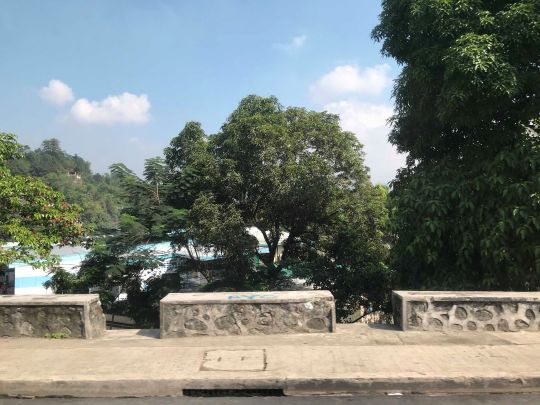
a. HAZARDOUS PLACES
The most hazardous place that was brought to my attention was the residential houses near the cliff, as we are part of Antipolo which is a mountainous area. There are some residential houses that are near a cliff, when certain disasters did appear or took place like landslides, earthquakes or possible tornado and cyclones, these houses will be affected directly or have an aftermath disaster.

b. SAFE SPACES
A safe area or space that was pointed out by the official was the Sto. Nino de Praga Parish church, near the barangay hall and the said schools in the area (We didn't get to go or visit the schools because it was quite far from the barangay hall and the official only has limited time to spare for the interview) These areas are the safest places as the barangay made sure that when these places are used for evacuation centers, they are already equipped with enough water supplies and as much as possible food and blanket storage.

c. BEST PRACTICES
I couldn't really capture the actual practices that was made by the barangay but the official did say that they conduct drills and seminars or information handouts to the community and when they get chances they give out flyers to the actual residential owners from house-to-house only to inform them of tips and needed regulations when disaster happens. Most importantly they give out flyers of telephone numbers that needs to be contacted when disaster happens and they do update this every 3-4 months as he said.
0 notes
Photo
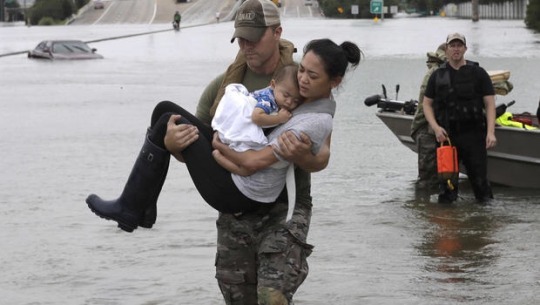
Five Lessons Hurricane Harvey Teaches Us By Dr. Erwin W. Lutzer Five Lessons Hurricane Harvey Teaches Us Did God have anything to do with the monstrous storm that wreaked havoc in Texas for several days? Some will argue that God was simply an interested observer; after all, the laws of nature rule in this fallen world. But intuitively people know that God was in charge. I’m sure that even those who had not prayed in years called on God in their distress, asking Him to control their circumstances. And, of course, as believers we know that God was not just an interested bystander. The book of Job is instructive here. God gave Satan permission to send wind and lightning to kill Job’s children but Satan could not act without God’s express approval. To be sure, nature is fallen and so earthquakes, hurricanes, and tsunamis occur, but Job knew that whatever the secondary causes might be, his calamity was traceable to God. “The LORD gave, and the LORD has taken away; blessed be the name of the LORD” (Job 1:21, italics mine). Who sent the flood during the days of Noah? Who sent the plagues that ravaged Egypt? Who sent the storm that caused the pagan sailors to throw Jonah overboard? In these and dozens of other passages, the Bible traces the ultimate cause of these disasters to God. He does not usually do them directly, of course, but the secondary causes of nature are also under His command. Jesus could have spoken the word and Hurricane Harvey would have become as calm as the waters of Galilee. God has His own reasons for these events which are unknown to us. But from Scripture we can glean what our response should be and the lessons to be learned. First: We Grieve, We Do Not Judge Jeremiah grieved alone. He was dismayed that others were so calloused that they could walk past the destroyed city of Jerusalem with dry eyes. “Is it nothing to you, all you who pass by? Look and see if there is any sorrow like my sorrow, which was brought upon me, which the Lord inflicted on the day of his fierce anger” (Lamentations 1:12). The destruction of Jerusalem did not just affect the wicked; the righteous suffered equally. Jeremiah grieved for both. Jesus, when speaking about a disaster in Jerusalem, asked, “Or those eighteen on whom the tower in Siloam fell and killed them: do you think that they were worse offenders than all the others who lived in Jerusalem? No, I tell you; but unless you repent, you will all likewise perish” (Luke 13:4-5). Here was a tragedy known and talked about in the city of Jerusalem. It is quite possible that this tower was an aqueduct built by Romans who were employing Jews in its construction. Of course the Jewish zealots would have disapproved of Jewish workers helping with a project that would benefit their despised oppressors. We can hear it already, “Those men deserved to die…they were victims of God’s judgment!” The self-righteous pointed fingers in those days too! Jesus affirmed that those who died when the tower collapsed were not greater sinners than others in Jerusalem. It was both morally wrong and self-righteous to sit in judgment on those who were killed so unexpectedly. From God’s standpoint, disasters might be meticulously planned, but from our perspective they occur haphazardly, randomly. Let our tears be translated into action, helping with our prayers, with our giving to organizations that help the distressed and, if possible, join others who are physically responding to those in need. We grieve for the people in places like Corpus Christi and Houston; we grieve we do not judge. Second: Values Are Clarified When that tower in Siloam fell, no one mourned the loss of the bricks, but eighteen families mourned the loss of a husband, father, or brother. As Max Lucado said back when Katrina hit New Orleans, “No one laments a lost plasma television or submerged SUV. No one runs through the streets yelling, ‘My cordless drill is missing’ or ‘My golf clubs have washed away.’ If they mourn it is for people who are lost. If they rejoice it is for people who have been found.” (1) He goes on to say that raging hurricanes and broken levees have a way of prying our fingers off the stuff we love. One day you have everything; the next day you have nothing. “For what will it profit a man if he gains the whole world and forfeits his soul? Or what shall a man give in return for his soul?” (Matthew 16:26). Disasters help us separate the trivial from the weighty, the temporal from the eternal. Suddenly what is most important becomes most important. Third: Life Is Uncertain Natural disasters confirm the words of James, “Yet you do not know what tomorrow will bring. What is your life? For you are a mist that appears for a little time and then vanishes” (James 4:14). The people who lose their lives in a natural disaster do not wake that morning telling themselves, “This could be my last day on Earth.” Collapsing towers, accidents, and floods happen without warning. When you read the obituaries of those who have died in sudden calamities, you should visualize your own name in the column. All of us know someone who has been unexpectedly killed in an accident, perhaps in a car wreck, at work, or by drowning, not to mention a heart attack. When we grieve with the families, we should remind ourselves that our own death could be just around the next corner. We are born with an expiration date. Tragedies rid us of the overconfidence we have that we are in control of our destiny. Disasters, in the words of David Miller, remind us that “Human existence on Earth was not intended to be permanent. Rather, the Creator intended life on Earth to serve as a temporary period in which people are given the opportunity to attend to their spiritual condition as it relates to God’s will for living. Natural disasters provide people with conclusive evidence that life on Earth is brief and uncertain.” (2) In one of his most popular books, C.S. Lewis imagines a lead demon, Screwtape, telling his underlings that war can be dangerous to their demonic agenda because it causes humans to think about eternity. If the demons are not careful “they might see thousands turning to the enemy [God] during this tribulation. In fact, it just might cause thousands to divert their attention to values and causes that are higher then they themselves…Thus, in wartime men prepare for death in ways they do not when things are going smoothly.” (3) Then the demon continues: “How much better for us if all humans died in costly nursing homes amid doctors who lie, nurses who lie, friends who lie, as we have trained them, promising life to the dying, encouraging the belief that sickness excuses every kind of indulgence, and even, if our workers know their job, withholding all suggestions of a priest lest it should betray to the sick man his true condition!” (4) Lewis believes—and I concur—that “contented worldliness” is one of the demons’ best weapons at times of peace. But when disasters come, this weapon is rendered worthless. He writes, “In wartime not even a human can believe that he is going to live forever.” This is one of the reasons why we will never know all of God’s purposes in natural disasters—we simply do not know the thousands, or perhaps millions, of spiritually careless people who were forced to take God seriously in a time of crisis. Even those of us who watch these calamities from a safe distance, hear God saying, “Prepare for your own death…it may be soon.” Fourth: We See a Preview of Coming World-Wide Judgments Let’s return to the words of Jesus as He speaks about the collapsed tower of Siloam, “But unless you repent, you will all likewise perish” (Luke 13:3). We’ve all seen a movie preview that gives us a glimpse of what is yet to come. Natural disasters remind us that severe judgment is coming. Depending on how you classify them, at least three or four natural disasters will accompany the return of Jesus to Earth: “For as the lightning comes from the east and shines as far as the west, so will be the coming of the Son of Man. Wherever the corpse is, there the vultures will gather. Immediately after the tribulation of those days the sun will be darkened, and the moon will not give its light, and the stars will fall from heaven, and the powers of the heavens will be shaken. Then will appear in heaven the sign of the Son of Man, and then all the tribes of the earth will mourn…” (Matthew 24:27–30). Convulsions of nature will eventually be a part of God’s sovereign judgment. Here is a future ‘natural disaster’ which is the real movie after the preview. “When he opened the sixth seal, I looked, and behold, there was a great earthquake, and the sun became black as sackcloth, the full moon became like blood, and the stars of the sky fell to the earth as the fig tree sheds its winter fruit when shaken by a gale. The sky vanished like a scroll that is being rolled up, and every mountain and island was removed from its place. Then the kings of the earth and the great ones and the generals and the rich and the powerful, and everyone, slave and free, hid themselves in the caves and among the rocks of the mountains, calling to the mountains and rocks, ‘Fall on us and hide us from the face of him who is seated on the throne, and from the wrath of the Lamb, for the great day of their wrath has come, and who can stand?’” (Revelation 6:12–17). We owe a great debt to those affected by Hurricane Harvey. What happened to them is a warning to us all. If we don’t repent we “shall likewise perish.” Fifth: While There Is Time, We Must Find Firm Ground Jesus likened a future judgment to a natural disaster. He ended the Sermon on the Mount by telling the story of two men: one who built his house on the sand, and the other on the rock. On a beautiful sunny afternoon they looked identical; perhaps the house built on the sand was even more beautiful than the one built on the rock. But a natural disaster revealed the difference between the two. “And the rain fell, and the floods came, and the winds blew and beat on that house, but it did not fall, because it had been founded on the rock” (Matthew 7:25). The other house could not endure the storm, “and great was the fall of it” (Matthew 7:27). Recall that the Titanic went under with 1,522 people knowingly going to a watery grave. At the White Star office in Liverpool, England, a huge board was set up; on one side was a sign titled: Known To Be Saved, and on the other, the words: Known To Be Lost. Hundreds of people gathered to watch the signs. When a messenger brought new information, the question was: to which side would he go? Although the travelers on the Titanic were either first, second, or third class upon boarding, after the ship went down, there were only two categories: the saved and the drowned. Just so, in the final Day of Judgment, there will be only two classes: the saved and the lost. There is only heaven and hell. God shouts from heaven, “Unless you repent, you will likewise perish.” 🙏🇺🇸💔
0 notes